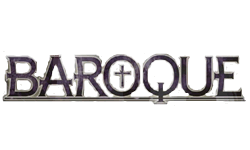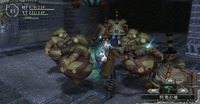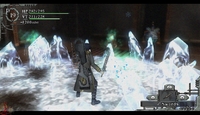|
|

|
PLATFORM
|
Wii
|
BATTLE SYSTEM
|

|
INTERACTION
|

|
ORIGINALITY
|

|
STORY
|

|
MUSIC & SOUND
|

|
VISUALS
|

|
CHALLENGE
|
Very Hard
|
COMPLETION TIME
|
40 to 60 Hours
|
|
OVERALL

|
+ Nonlinear gameplay with no hand-holding.
+ Graphics and sound add to the creepy atmosphere.
+ High difficulty for those that enjoy that kind of thing.
- Combat can be dry, but still enjoyable.
- Low healing item drop rates can lead to large wastes of time.
- Lack of direction sure to turn off some players.
|
Click here for scoring definitions
|
|
|
Baroque is Atlus' first RPG for the Wii and their latest for the PlayStation 2. Originally released on the Sega Saturn, it has been updated graphically for the more powerful hardware. Be forewarned: this game is designed specifically to promote hair loss amongst its players--it is that hard.
A Baroque is a distorted fantasy. In game terms, it means a person who cannot feel pain. It appears as if the world was destroyed in some major war and only the Baroques of some people survive. The whole premise is very confusing and after having completed the game, it is safe to say that it never really clears up.
The main character, simply called the Protagonist, is a young man who suffers from guilt for actions that he cannot remember committing. The Archangel, the leader of the survivors, informs him that it is his fault that the world has decayed to its current state. He then hands the Protagonist a blessed gun and bids him to heal the world by killing a divine being at the bottom of the Neuro Tower.
The Neuro Tower is a randomly-generated dungeon that contains many floors. Depending on progress in the storyline, the tower gets deeper. The Protagonist must complete whatever goals he has set before him within the tower before reaching the bottom floor, which acts as the exit. It is never clear what the goals are--it is up to the Protagonist to piece the clues together to find out what he must do.
Clues are available in either the Outer World (the area that the Protagonist can explore before entering the tower), as well as the Neuro Tower itself. Vital NPCs give little tidbits of information that lead the Protagonist to piece together the current goal, and often they must be consulted many times before getting useful information.
Sometimes the story can only be pushed ahead by the Protagonist losing his life. Yes, death is very important here. By reaching the bottom level of the tower, or by dying within its walls, the Protagonist dies, and reappears outside of the Neuro Tower. This allows him to gather more information, as well as progress the storyline. In fact, it is far preferable to commit suicide a few times to simply push the story forward instead of spending the time to explore the tower. Why? When the Protagonist leaves the tower by either method he drops back to level one and loses all his equipment. Also, if any quest items were being carried, they are lost, unless branded to stay with the character after death. Losing quest items forces the Protagonist to restart the entire quest line from the beginning. Of course, losing quest items is a lot easier than in most other games.
Equipment can be stored during his travels by being tossed into orbs that are strewn about the tower. Each orb can only transfer one item to the outside world and is picked up by a little kid known as the Collector. These items can be retrieved in the Outer World on the next life by smacking the little brat around. Strategically transferring secondary gear can make return visits to the tower a lot easier.
 This is gonna suck--my gas mask broke!
This is gonna suck--my gas mask broke!
|
|
So basically, the game progresses as follows: the Protagonist tries to figure out what he must do by talking to everyone in the Outer World and then he must repeatedly climb the Neuro Tower until he figures out what must be done. At this point he must climb and accomplish what he suspects that he must do. It can be hilarious at times how some NPCs will actually lie, so it is up to the Protagonist to figure out which clues are the real ones. On another note, it is possible to progress in the story in different ways: if the Protagonist can't figure out what to do on his own, the game will throw out more hints or accelerate the events to help him out.
The characters in the game are well designed. It is apparent that Sting took the time necessary to give each character a personality, which helps when it comes to deciding if they are telling the truth or not. The majority are just plain creepy, which really works to the game's advantage. A favorite character is the Coffin Man, a dungeon designer who insists on training the Protagonist and cusses every chance he gets.
Unfortunately, combat in Baroque is not always as exciting as it could be. The Protagonist has three things he can do: swing his sword, swing it harder, and throw stuff at enemies--there is no fancy dodging or blocking available. Most battles will see him going face-to-face against one or more opponents and just hoping he will survive the onslaught of damage. Items can be used or thrown at any time via the in-game menu, which makes healing a little bit quicker and easier to pull off. The thrown items, traps, and spell effects are all flashy and when used properly, can drastically turn the tides of battle. Strategically using items is the key to success on the harder difficulty levels.
On top of having regular hit points, the Protagonist also has vitality points that he must keep high, as doing so will allow him to regenerate hit points over time. This is a danger because VP constantly depletes, regardless of what he does. This is done to ensure that the Protagonist constantly moves and limits downtime. When his VP reaches zero, his HP gradually decreases. Items must be used to keep both of these totals high, or his trip in the tower will come to an end. Unfortunately, these items must be obtained in the tower itself and hoarded for later use. Also, since the Protagonist is only allowed to carry a certain amount of items with him at a time, and the relative scarcity of healing items on later floors, management of these resources becomes a big pain. Luckily, fallen enemies have a chance of dropping either a vitality orb, or an item at death. Collecting these orbs allows the Protagonist to extend his stay in the Neuro Tower by healing a couple points of lost VP.
A second difficulty comes in the form of the nasty status effects that the Protagonist is bound to be affected by. Poison wreaks havoc to his HP and VP. Paralysis and blind decrease his combat effectiveness. Lust is the most original of the status effects, as it turns every enemy and item into scantily clad women, hiding their true identify. This can lead the Protagonist into unwittingly attacking something that he would rather not face at the time.
Little disks are found littered around the tower. These are player or monster laid traps (there are also typical dungeon crawler traps here, but they aren't that interesting). These disks do everything from exploding to freezing everything in the nearby area, but these are far from the worst available. The worst are the traps that transmute items that the Protagonist carries. Does he have an extremely nice sword? Hit a trap and he may now have a shiny new seed instead. Such traps often take out more than one item at a time: losing weapons, armor, or both can lead to a very quick death. Quests items are not immune to these traps, and usually the worst possible item to lose is the one that goes. Of course, the Protagonist can also lure enemies into any available traps for some quick and easy experience points.
 Man, who turned the heat off?
Man, who turned the heat off?
|
|
One of the keys to victory is the careful upgrading of equipment. The Protagonist will pick up an assortment of parasites, brands, potions, and even traps that can be used to apply effects to the gear he is wearing. By adding effects and transferring the modified equipment into orbs, he can save them for future trips into the dungeon. Doing it often enough will see the equipment ready to take on any foe with ease.
Of course, it goes without saying that the combat is hard. Everything considered, as of the middle of the game, enemies start hitting a lot harder, and can take down the Protagonist in a couple of lucky hits. Towards the end of the game, healing items must be rationed, as one false step can see Protagonist eating dirt and needing to start anew.
With the Wii-mote in hand, Baroque doesn't play very well and it is especially hard to control the camera. This is easily fixed by using the classic controller--making the game play like the PlayStation 2 version, which is a tremendous improvement over the original control scheme. The game does have some use for the Wii-mote: strong attacks are pulled off with a Wii-mote waggle, or by hitting Y on the classic controller.
The visuals are not spectacular compared to other offerings from this generation, but it is a remake after all. The fog that covers the Outer World and a good portion of the tower interior just emphasize the creepiness that the game tries to exude. The characters are also designed to do that. The enemy models are all weird looking, but they really suit the mood of the game. So while not technically stunning, they do a real good job of portraying the feeling that the game is trying to set, which is all that is really important in the end.
Similar to the visuals, the sound work is also well done, but not very memorable. The sound effects don't really do anything that hasn't been heard before, but the voice work just enhances the creepy nature of the game. At times a creepy voice will speak lines at random while exploring the tower: the timing of these instances is just impeccable, and further serve to enhance the atmosphere.
Technically, Baroque is not a particularly long game, but figuring out what needs to be done will eat away a lot of time. A single run through the tower could take upwards of seven hours when it is at its maximum depth. At least two or three runs through the tower are necessary to complete the game. Even so, it is quite possible that the Protagonist will not see every available cut scene in the game. Also, depending on the Protagonist's decisions throughout the game, different endings are available. For those that want to extend their play time, there are different lists of things to collect, such as items, conversations, and cutscenes, amongst others.
The difficulty of the game is much lowered by the ability to save after each floor. Lose a favored weapon? Reload. Die? Reload. Of course, saving this often can lead to issues of item mismanagement. Death follows very quickly once a floor is entered with an inadequate item supply. Also, the game has multiple difficulty levels with all the above issues being really pronounced on hard mode.
Baroque is not a game for everyone. Its focus is on the danger of exploring a deep dungeon where anything can happen at any moment and not really on the story or the interactions between the characters. It is all about the creepy nature of what is there as well as the convoluted storyline that keeps the player guessing. It is well suited for players that love rogue-like games or simply love delving deeper into games to discover what has to be done on their own. Of course, playing by a FAQ will get the player through the game much quicker, but a lot of the feeling of accomplishment dissipates by doing so. For those that are looking for an intricate storyline, or a game that just feels epic, this game is definitely not for them.
Review Archives
|









